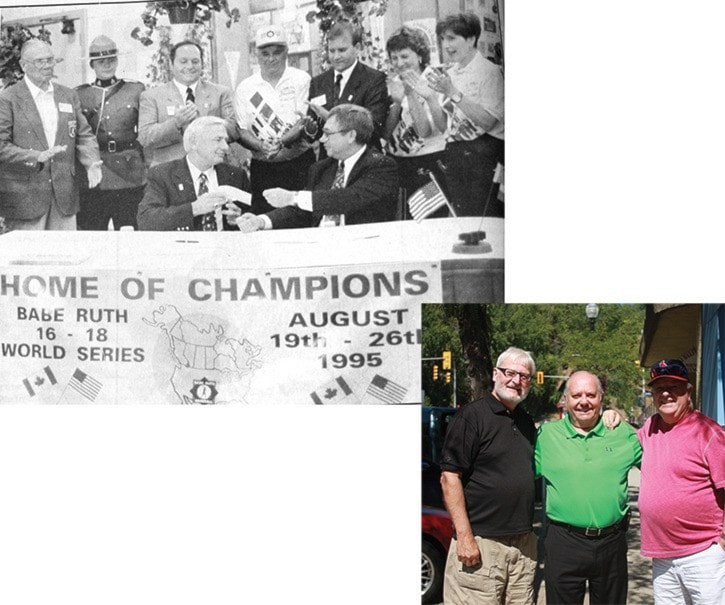Twenty years ago, almost to the day, Greater Trail hosted arguably the most prestigious and memorable event in its sporting history – the Babe Ruth World Series. For the next three issues, Trail Times Sports will take a walk down the base paths of time, and revisit the tournament that ran from Aug. 19-26, 1995; highlighting its evolution, its players, and those that made the event possible.
Hosting the Babe Ruth World Series is not just a good story of a great sporting event, but, more, it is a shining example of what a community can do when galvanized by a simple idea and the will to make it happen.
The notion of bringing the age 16-18 Babe Ruth World Series to Trail was first tossed out by Art Mercer, chair of the 1991 Pacific Northwest Regional baseball tournament. Having hosted three successful regional tournaments, Mercer suggested to long time Babe Ruth baseball coach, Brian Pipes, that the Silver City should take a shot at the Babe Ruth World Series.
Pipes was pessimistic at first, after all the Series had never been held outside the United States, but a conversation with Dan Ashman would change all that.
“That was the seed that was planted,” said Pipes. “And then Danny and I are good friends, so I see Danny one day, and say, ‘you know what Art threw at me?’ He said, ‘What?’ -‘A world series.’ And he says, ‘Okay, why not?’”
Once Ashman jumped on board the A.M. Ford owner and consummate community supporter developed a prospectus. Following a consultation with regional commissioners, he sent the inquiry to Babe Ruth Inc. headquarters in Trenton, New Jersey.
A positive phone call later invited Pipes, Ashman, and fellow executive director Eleanor Gattafoni-Robinson to a World Series school and orientation in Jamestown, N.Y., where they learned the finer points of hosting a successful Series.
Meanwhile, the Trail 1995 Babe Ruth World Series Organizing Committee was growing, and the initiative gaining momentum.
Doug Stanley was installed as Host President, Keith Smyth to recruit volunteers and chair the administrative division, Adie Tambellini, was brought in as government liaison, Gail Rebelato as executive assistant and many, many others.
“The key was Doug Stanley at the top,” said Smyth. “He knew how to control money, and he kept the budget well under control.”
Brian Pipes agreed adding, “He was the guy that could go pick up the phone and get something done . . . But there was a lot of key people in there.”
After Ashman watched his son’s baseball game get cancelled because the clay infield was full of water from the sprinklers, he recognized almost immediately that improvements needed to be made to Butler Park. In 1991, the upgrade known as “Butler 2000” officially broke ground.
Ashman brought in Rud Haar, the groundskeeper at Nat Bailey Stadium in Vancouver. With Haar’s expertise, the support of the City of Trail and Cominco, which donated equipment and manpower, the field was transformed ahead of schedule into a world class stadium.
A top-notch field was a major step in securing the Series, the other was the detailed planning and organization of volunteers.
Smyth and his team set up shop at the old Texaco Garage on Victoria St. and after a quick makeover, combined with the visibility of the Trail Babe Ruth World Series sign, it didn’t take long for residents to buy in.
The first thing Smyth did was create an organizational chart, fill all the roles, and put responsible people in place.
“Being one event, there was a real camaraderie because you are working with top level people on this one,” said Smyth. “You really create an alliance of people who are on board and once you get that head group on board you have a good leadership quality, and that’s necessary, you have to start from that.”
By November ‘92, the committee had sold over 500 family passes, had 35 per cent of the billets in place, and secured corporate sponsorship. But perhaps the most crucial point of the process came during the Babe Ruth World Series Task Force site inspection in July ‘93.
Led by Babe Ruth president and CEO Ron Tellefson, the inspection would make or break Trail’s bid for the Series. Highlighted by a dinner sponsored by the Ferraros and the overall impression made by the impassioned volunteers and residents of Greater Trail on the Task Force, Tellefson told the Times, “This is a vibrant, friendly community . . . and your facilities are as good or better than any we’ve seen.”
For Ashman, that visit sealed it for Trail.
“He (Tellefson) knew we had a baseball background, he knew there had never been a World Series held outside the continental United States, but there was an appetite to hold one.
“I think the difference was two things, one when he came here and visited the city, he saw the passion of the people on the committee, the people on the sub-committee, we had it all organized like we do in Trail. The other thing is he saw the pride in the homes and pride in the community.”
In October ‘93 Babe Ruth Inc. announced that Trail’s bid was successful and the Silver City would become the first Canadian city to host the Babe Ruth World Series.
In a letter to Stanley prior to the Series, Tellefson made a bold but ultimately sound prediction:
“In all my years with Babe Ruth Baseball, I have never seen a community more organized for the Spring Visitation than Trail.
“I sincerely believe that Trail will host one of the finest World Series ever in the history of Babe Ruth.”
